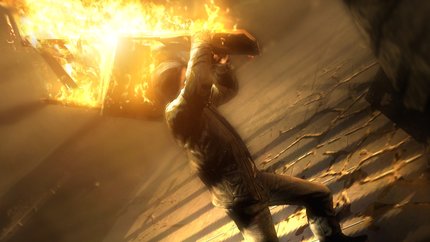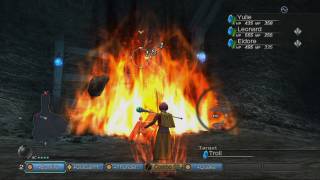Overview
Fire is the result of many exothermic reactions, giving out energy in the form of heat and light. Fires can be used for anything from keeping warm and providing light when out doors to destroying objects such as evidence. Three things are essential to it's creation and sustainability; A fuel (Paper, wood, cardboard, fabric, fat, etc.), Oxygen and an ignition source (A spark, open flame, lightning, etc.). Fire creates CO2 gases when alive and if big enough, the amounts of Co2 gases can be enough to suffocate someone and eventually kill them.
Use in Games
Fire has many different forms in video games. First of all, it can be a major obstacle for your character to overcome, such as a burning building or a magical wall made of fire. While fire can be a nuisance in some games, it can be a valuable tool in others. For example, in
The Elder Scrolls IV: Oblivion your character uses torches to enhance their visibility in dark areas such as caves or dungeons. Many games with a magic system tend to have a fire spell or two, increasing in power as the game continues. This feature required developers to work on realistic lighting effects, like making the light emitted from the flame flicker to enhance the realism.
 Lighting chairs on fire, arguably the best part of Alone in the Dark. Swinging them was a completely different story.
Lighting chairs on fire, arguably the best part of Alone in the Dark. Swinging them was a completely different story. Dynamic fire has been tinkered with in various games such as Far Cry 2 or Alone in the Dark (2008). In Far Cry 2 it was possible to ignite the tall and dry savanna grass with a flamethrower near an enemy encampment and watch the flames spread into the enemy's nest. While sometimes useful, this feature could also be highly unpredictable, leaving the player burned to death or trapped in the middle of nowhere since all of the vehicles burned. Alone in the Dark featured enemies that could not be completely killed by bullets or bludgeoning. In order to keep these ghouls from rising back up again, the game allowed for a player to beat an enemy with a chair and then ignite that chair on nearby burning rubble and use their homemade torch to burn the body. The game also featured fully functional flammable liquid which could be spilled out in trails by the player or small fuel canisters that could be punctured and attached to enemies, forcing them to create a trail of fuel. The fuel could be ignited by numerous means: homemade torches (chairs, lumber), cigarette lighter, or "fire" bullets.
Many games also have fire based weapons. For example, one of the weapons many people talked about was the addition of a flame thrower in
Call of Duty: World at War. People noted the flame thrower being very effective against infantry in close range. Most games have fuel as the main source of "ammunition" for fire based weapons in order to give the player a sense that the weapon worked as it would in real life. As mentioned above, some games, such as
Bioshock, have incendiary rounds built into the game.
In real time strategy games, fire-based weaponry would generally be effective against infantry while weak or ineffective against vehicle units. However, its effects can also vary between different game genres. While fire may just be effective

against infantry in an RTS, many RPGs have spells that involve fire. In this case, fire can become the form of an elemental spell that is effective against certain elements but not others. In addition, it can also cause cumulative damage, burning the enemy for a period of time. Fire has also been very common in arcade-style racing games in the form of boost, allowing the player to reach high speeds at the cost of mobility.
Though it's a bit of a rare occurrence, in games like
Legend of Zelda or
Darksiders, fire is used to solve the many puzzles found in dungeons. These puzzles can range from lighting torches in the correct order to melting ice that has frozen a door shut. It is very common as an environmental threat where it blocks doors and you have to solve the puzzle in order to deactivate the fire.
Log in to comment